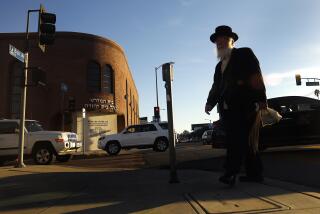Park Menorah May Be Lighted Despite Threatened Lawsuit
- Share via
An Anaheim rabbi said Thursday that he expects to light a 10-foot Hanukkah menorah on public property when the festival begins at sundown tonight, despite the threat of court action by the American Civil Liberties Union to halt the ceremony.
Rabbi David Eliezrie said that he planned to light the first candle of the eight-day holiday in Sasser Park, across from the Civic Center in Santa Ana, where a lighted Christmas tree has been displayed for years.
The ACLU has challenged menorah-lighting ceremonies on the ground that they violate the separation of church and state.
But Eliezrie said Thursday that the permission given him by Allen Doby, a city administrator, is valid.
“The ACLU has lost cases in three cities in the last two weeks” on this issue, Eliezrie said, “in Pittsburgh, Seattle and Los Angeles, as well as other cases in previous years. They have no legal grounds for their case and I can’t understand why they continue to pursue an avenue of litigation that they continually lose.”
Representatives of the ACLU and the City of Santa Ana could not be reached for comment Thursday, but United Press International reported that Meir Westreich, vice president of the ACLU’s Southern California chapter, said the organization plans to ask the city to prohibit the candle-lighting. If the city refuses to bar the ceremony, said Westreich, a Santa Ana attorney, the ACLU would request a temporary restraining order in Orange County Superior Court.
Eliezrie, who is affiliated with Chabad, an Orthodox Hassidic group, said that “if there were no religious symbols on public property in the United States, Chabad would not advocate the placement of menorahs. However, the reality is totally different.”
A similar dispute, also involving a Chabad rabbi, city officials, the ACLU and the American Jewish Committee, has taken place for the last three years in Los Angeles.
In 1985, Los Angeles Superior Court Judge Irving Shimer ruled that a menorah provided by West Coast Chabad could be displayed in the city hall’s rotunda, because it was a symbol. However, he also ruled that lighting and blessing the candles would constitute a religious ceremony in an area with limited public access, so those activities would have to take place outside the rotunda.
Shimer, who said he would be kindling his own Hanukkah lights that evening, said that displaying the menorah would only call “to the attention of the public that Jews at this time of the year are celebrating a particular kind of holiday.”
20-Foot Christmas Tree
An attorney for Chabad had argued that the menorah was no more a religious symbol than the 20-foot lighted Christmas tree in the rotunda.
Rabbi Boruch Shlomo Cunin of Chabad called Shimer’s 1985 ruling “a phenomenal victory.”
This year, Superior Court Judge Robert H. O’Brien rejected a challenge by the ACLU to the dual display in the rotunda and the lighting on the steps.
“Many things in American public life have religious significance,” O’Brien wrote. “Much of our government activity stresses religious foundations. The applicable constitutional provisions do not require purging of all religious symbolism in our public life.”
Display of History
The menorah, O’Brien wrote, “presents the citizens of Los Angeles with a visual display of history and culture. The display will undoubtedly educate and enlighten citizens and this serves a valuable public purpose.”
“The judge has basically said that anytime somebody comes forward and says a religious symbol has an educational significance, it’s permitted,” said ACLU attorney Carol A. Sobel. “There are close to 800 recognized religions in this country, and I certainly hope that each and every one of them demands a space in the L.A. city hall rotunda.”
A representative of Chabad, Marshall Grossman, said that the organization has asked to place the menorah in the rotunda mainly because the Christmas tree was there.
“Our preference would be that there be no religious symbols in government buildings, but . . . it would be hypocritical and cruel to deny this very simple, elegant expression of holiday good will while permitting another.”
The ACLU this year also challenged the display of a nativity scene at a public park near the Downey city hall, but a Los Angeles County Superior Court judge postponed a trial on the issue until after Christmas.
In 1984, the U.S. Supreme Court ruled that a city nativity scene in Pawtucket, R.I., could remain in a downtown shopping district because it represented a “traditional symbol of a national public holiday.”
More to Read
Sign up for Essential California
The most important California stories and recommendations in your inbox every morning.
You may occasionally receive promotional content from the Los Angeles Times.










